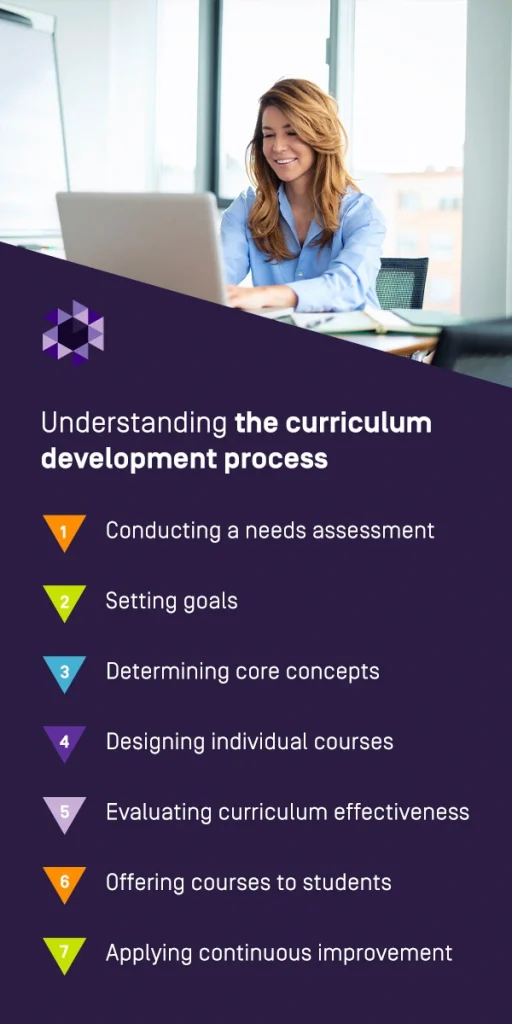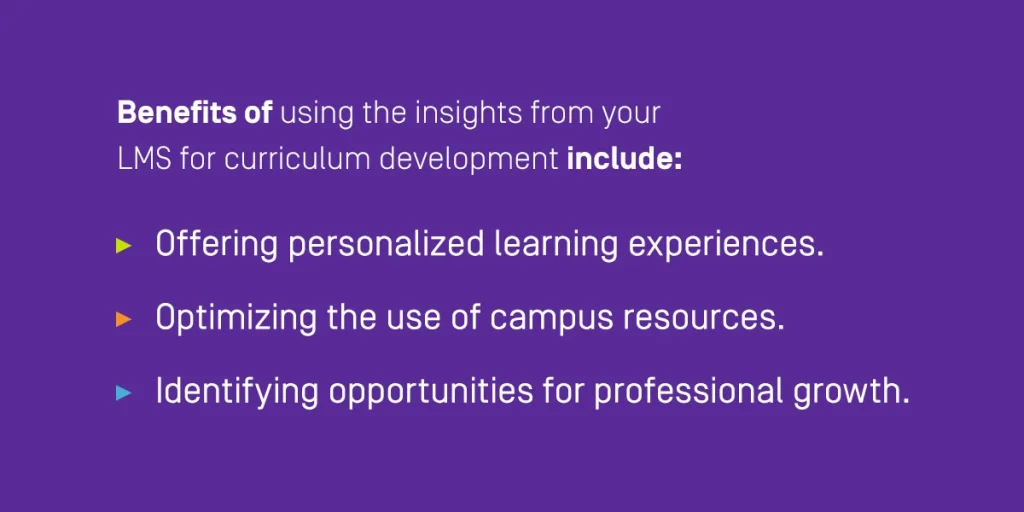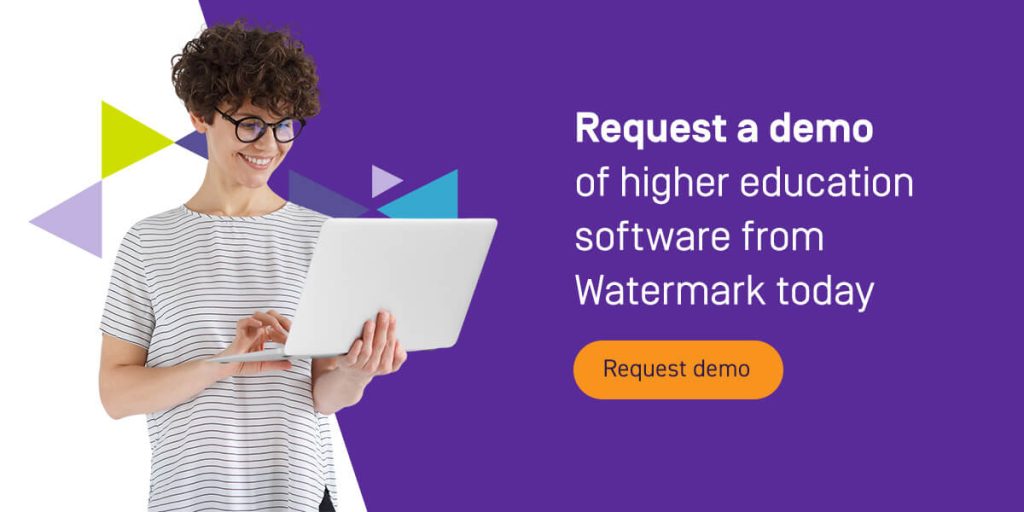




A learning management system (LMS) is an incredible tool for higher education institutions looking to optimize their academic programs. These solutions offer extensive insights that can inform and support efforts to enhance curriculum development at your college or university.
Leveraging LMS data analytics can help your higher education institution optimize its curriculum development processes and deliver better student experiences.
Learning management system data is highly beneficial for informing curriculum development. To understand the role of these insights, you must first understand the basics of this process.
For most colleges and universities, the curriculum development team works through a few basic phases:

Learning management system data is highly useful for curriculum development as it helps colleges and universities analyze the following:
In addition to these insights, LMS data allows for more personalized learning experiences. Your institution can learn a lot about individual student needs by analyzing this information and using its insights to tailor the curriculum to suit a wider range of learning styles and better serve each learner.
LMS insights also provide valuable, evidence-based understandings that are useful for informing decision-making throughout curriculum development. Universities and colleges can quantify LMS data and use it to validate important choices.
A learning management system can collect various types of data:

The ultimate benefit of using LMS data for curriculum development is being able to make evidence-based decisions to improve the quality and effectiveness of each course offered at your institution. Updating your processes, course materials, and teaching styles with these insights in mind can help your college or university deliver the best student experiences possible.
Additional benefits of using the insights from your LMS for curriculum development include:
Data is essential to developing the most effective, comprehensive, and impactful curriculum, elevating your higher education institution’s overall deliverables for students and faculty.
LMS data analytics helps institutions identify trends and opportunities for growth. Explore the following eight tactics for boosting your college or university’s curriculum development processes:
One way higher education institutions can capitalize on LMS data is by using it to determine student performance baselines. Begin by analyzing the data collected from the system that outlines assessment results, engagement, and course progress. Every student is unique and learns in their own way, which means baselines are simply tools to gauge success compared to average performance in a course.
Specific benchmarks will help your institution manage student learning outcomes and ensure they acquire the knowledge needed to thrive after graduation. Establishing these standards is an important part of the curriculum development process because baseline data is integral to:
You can also utilize your institution’s LMS data analytics to measure the likelihood that a student will complete their courses successfully and on time.
Learning management system data can also boost curriculum development by offering the necessary insights to provide students with more personalized learning experiences.
Identifying each learner’s progress, strengths, weaknesses, prior knowledge, specific academic goals, and individualized learning styles can help your institution develop tailored learning paths to benefit students. These paths include challenging but attainable roadmaps to graduation that better support how each individual learns. Higher education institutions can use these insights to supercharge curriculum development and create more flexible learning programs.
Offering adaptive learning paths is an excellent way for your college or university to support each student while setting them up for success in acquiring their degree. Offering personalized learning experiences can give your institution a competitive edge and help your student body excel.
The data higher education institutions have access to through an LMS can help curriculum development teams assess whether or not students are meeting predetermined benchmarks for success and achievement.
As your college or institution works through curriculum development, it can utilize these insights to update and refine learning outcomes that better reflect the competencies that you expect students to acquire by completing each course.
You can evaluate LMS data analytics for college student success markers and use these insights to inform improvement efforts. Learning outcomes should be specific, measurable, and aligned with your institution’s mission.
Sample learning outcomes include:
Institutions can use learning management system insights to monitor and analyze student engagement levels throughout different courses and programs. The data analytics from your college’s LMS can help you track key engagement metrics, such as:
By looking closer at the data, your team can identify patterns and opportunities for improvement within the existing framework. These insights can inform curriculum development to devise more captivating and effective courses.
Design teams should consider ways to enhance student engagement wherever possible. Students who consistently remain focused, participate in class, and apply critical thinking throughout a course’s duration tend to have significantly greater takeaways than those who do not.

The curriculum development process can benefit from using LMS data to quickly identify knowledge gaps or other areas where students are likely to struggle throughout a program. By flagging historically challenging topics or concepts in the coursework, colleges and universities can implement more effective resources to support greater success.
Having data about the following makes it easier for your institution to find common patterns in student behavior and performance:
These metrics can offer insight into the effectiveness of course materials and teaching methods. If there is a particular knowledge gap, your curriculum development team can work to introduce stronger learning experiences around that concept.
Another way to boost curriculum development is by utilizing LMS data to track student progression in the longer term. Your university or college can monitor how learners perform across various courses as they move through their schedules on each semester. Assessing these insights over time can help your team determine the smoothest advancement to more advanced courses.
Many courses require a foundation of key principles students must have to succeed and adequately understand core concepts. You can utilize learning management system data to determine the best sequencing of courses within each program based on historical performance.
Students who have the necessary building blocks and knowledge at the beginning of a new course are more likely to do well, stay on pace, and connect with the learning content.
Student feedback is an important part of curriculum development. Their insights can help shape and enhance your institution’s academic programs in various ways. Colleges and universities can use this information to gauge the effectiveness of course materials and certain teaching styles.
A common challenge of student feedback is turning it into quantitative data that your curriculum development team can use to efficiently analyze. Learning management systems often feature built-in feedback and course evaluation tools that simplify the entire process. Your institution can quickly gather and assess what your students say about various courses, faculty performance, or degree roadmaps.
Colleges and universities can use learner input to inform and refine curriculums to meet more student preferences and demands.
More than 1 million students drop out of higher education institutions each year. You can optimize your college’s LMS by using data analytics to identify at-risk students before they leave.
Learning management systems can gather and provide historical insights that make it easier to see where students are most likely to discontinue their degree pursuits. Metrics like grades, attendance, and participation can all be useful in determining if a student could use additional support.
Colleges and universities can work to boost student retention rates by implementing more resources for struggling students throughout curriculum development. They can also use these insights for early intervention to increase the likelihood of that individual remaining actively enrolled.
Ultimately, LMS data helps institutions foster greater retention by adapting curriculums to align with learning outcomes and support student success.
If your higher education institution is looking to leverage LMS data for curriculum development, turn to Watermark. We have more than 20 years of experience helping colleges and universities make informed decisions to improve and evolve their institutions.
We’ll simplify and streamline data integrations with your campus systems so you can automatically capture data from your LMS and student information system (SIS). Our software integrates with all Learning Tools Interoperability-certified LMS platforms.

Are you interested in learning more about our solutions? Request a demo of higher education software from Watermark today.





























































































































































































































































































































































































